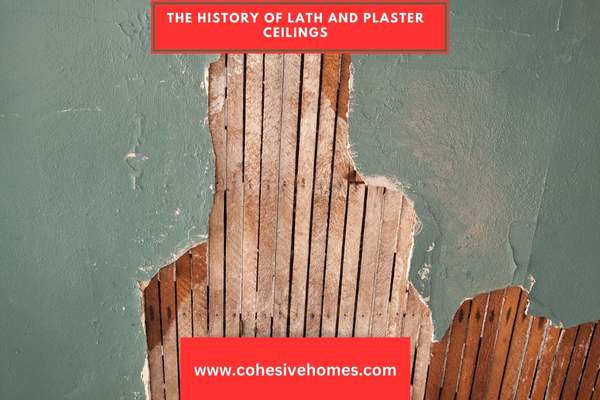Have you ever looked up at a ceiling and wondered what that criss-cross pattern of boards was underneath the paint? Chances are, you were looking at a lath and plaster ceiling—a type of ceiling construction that has been used for centuries.
Lath and plaster ceilings were once the most common type of interior finish, found in many homes built in the early to mid-20th century.
While this type of ceiling has mostly been replaced by drywall or other materials, it can still be found in some older homes.
In this article, we’ll look at what lath and plaster ceilings are and how they differ from other types of ceilings.
We’ll also discuss their advantages, disadvantages, cost estimates, and more. By the end of this article, you’ll be an expert on lath and plaster ceilings!
What Is a Lath and Plaster Ceiling?

A lath and plaster ceiling is a wall and ceiling construction method that relies on a timber web lath framework, known as a frame, which is then plastered over to create a smooth and level surface.
Builders commonly used lath and plaster ceiling in older buildings, particularly in the UK, for centuries as a traditional method of construction.
Because it is an historic construction type, having a lath and plaster ceiling has many advantages.
For example, this method of construction has superior soundproofing qualities compared to modern materials such as gypsum plasterboard.
Furthermore, the natural materials used are breathable, which allows damp walls to dry out faster than with modern construction methods.
Lath and plaster ceilings offer flexibility, making it easy to construct hard-to-reach areas such as alcoves or corners into shape.
This makes lath and plaster ceilings well suited for more intricate designs compared to modern construction methods, which often require pre-made boards that are difficult to work into shape.
The History of Lath and Plaster Ceilings

Lath and plaster ceilings date back to the 16th century, when they were used as a cost-effective method of creating a beautiful ceiling in homes.
Lath and plaster remains in widespread use today due to its durability and strength.
Builders install laths, which are wooden strips, on an already-existing wooden frame or ceiling to create lath and plaster ceilings.
The laths are then coated in multiple layers of wet plaster, which hardens and provides a solid surface for painting or wallpapering over.
Lath and plaster ceilings provide natural soundproofing and are customizable to any size or shape.
Plus, it’s relatively easy to maintain—just make sure to keep your ceilings free from dust and dirt as much as possible so that the surface remains smooth and clean.
If you’re looking for an esthetic way to add texture and depth to your home while still getting strong protection from sound, then lath and plaster could be the perfect solution for you!
Benefits of Using a Lath and Plaster Ceiling

One of the best things about a lath and plaster ceiling is that it’s incredibly durable and long lasting.
This means you can count on your ceiling’s beauty and strength for decades to come.
Unlike gypsum or drywall, which can be prone to cracking and denting, a lath and plaster ceiling is designed to stay intact for your lifetime.
Plus, if needed, it’s easy to repair small chips or cracks.
Lath and plaster ceilings offer plenty of other benefits too:
- Since they are fireproof, they can act as an additional layer of insulation in the home.
- They also absorb sound more effectively than drywall ceilings, making them ideal if you have a large family home or live in an apartment building.
- And unlike drywall, lath and plaster ceilings are more resistant to water damage because the plaster provides stronger adhesion than other compounds like drywall mud.
How to Install a Lath and Plaster Ceiling

Installing a lath and plaster ceiling might sound intimidating, but it’s really not that bad once you know what to do. Here are the basic steps:
Preparation
Before you begin any installation, make sure you have the right tools and materials.
In addition to your lath and plaster, you’ll need an orbital sander, router, or saw, joint compound, mesh tape, screws, and a caulking gun.
Apply the Lath
Next up is attaching the laths themselves to the ceiling joists.
These are thin wooden boards that run along the length of the room—you’ll attach your lath to them.
First step? Use a saw or router to notch out each board so that it fits snuggly against each other. Once they’re cut to size, screw them into place.
Preparing for Plastering
Once all the boards are up, it’s time to get ready for plastering by adding metal or fiberglass mesh tape where necessary over any seams between the boards.
This will help hold the plaster together and make sure everything is securely in place when you go in with your trowel later on.
The last step before actual plastering is using a caulking gun to fill any large gaps between boards with joint compound—this will create an even surface for when you apply your plaster to get nice, clean lines every time!
How to Repair or Replace a Lath and Plaster Ceiling

If your lath and plaster ceiling is in need of repair or replacement, the process is labor-intensive but not overly complicated.
Knowing how to do it yourself can save you a lot of money.
Removing Old Plaster and Lath
The first step is to remove the old plaster and lath—using a hammer and chisel, you’ll chip away any loose pieces, then pry out any nails.
It’s important to be careful so as not to damage the wood lath beneath.
Installing New Lath Strips
To replace a lath and plaster ceiling, builders need to install new strips of wood or metal lath after removing the old plaster and lath.
Nail each strip into place, making sure that they’re tight against one another with no gaps that could allow plaster to seep through.
If necessary, use a saw to cut strips for an even better fit.
Applying the First Layer of Plaster
You’re now ready to apply the first layer of plaster in order to secure the laths and create an even surface for further finishing layers of plaster.
A hawk and trowel are helpful here: scoop up a handful of plaster with the hawk, then level it out with the trowel onto your newly-installed strips of lath.
Repeat this process until you’ve covered all areas where there were previously old plaster and laths. Then leave it for 24 hours for drying time before moving on!
Pros and Cons of Having a Lath and Plaster Ceiling

You’ve probably heard of lath and plaster ceilings before, but did you know that they have several advantages and disadvantages?
Let’s take a look at what they are.
Pros
First off, one big advantage of a lath and plaster ceiling is the improved soundproofing.
Plaster absorbs sound more than drywall, so if you’re looking for peace and quiet in your home, this type of ceiling is worth considering.
Lath and plaster ceilings are great for insulation as they can trap hot or cold air inside the plaster coatings without much difficulty.
Plus, they’re more esthetically pleasing compared to drywall ceilings because the plaster can be finished to create an elegant, rounded look in some cases.
This makes it popular with people who like traditional decor styles.
Cons
On the other hand, lath and plaster ceilings aren’t as strong as drywall, which means they aren’t as suitable for homes with kids who are prone to banging things around.
It can also be more expensive than drywall because its installation processes are more labor-intensive. And even if it does get damaged, repairs are often expensive due to their complicated nature.
So there you have it: lath and plaster ceilings do have some clear benefits when used the right way but might not be suitable for certain scenarios depending on people’s needs.
Conclusion

In conclusion, a lath and plaster ceiling is an old-fashioned, elegant ceiling system that offers great acoustic and thermal insulation and can last for a long time if properly maintained.
Although it is labor-intensive and time-consuming to install and repair, it can add a sense of grandeur and charm to any home.
If you’re looking for an authentic ceiling that will stand the test of time, lath and plaster might be just the thing—just make sure you budget for all of the labor and materials involved.
FAQS
What is a lath and plaster ceiling?
A type of ceiling construction that uses thin strips of wood (laths) and wet plaster.
How can I tell if my ceiling is lath and plaster?
Look for visible seams, cracks, or small holes, or tap the ceiling to hear a dull thudding sound.
How do I repair a lath and plaster ceiling?
Remove damaged plaster, apply new plaster in layers, let each layer dry before the next, or hire a professional plasterer.
